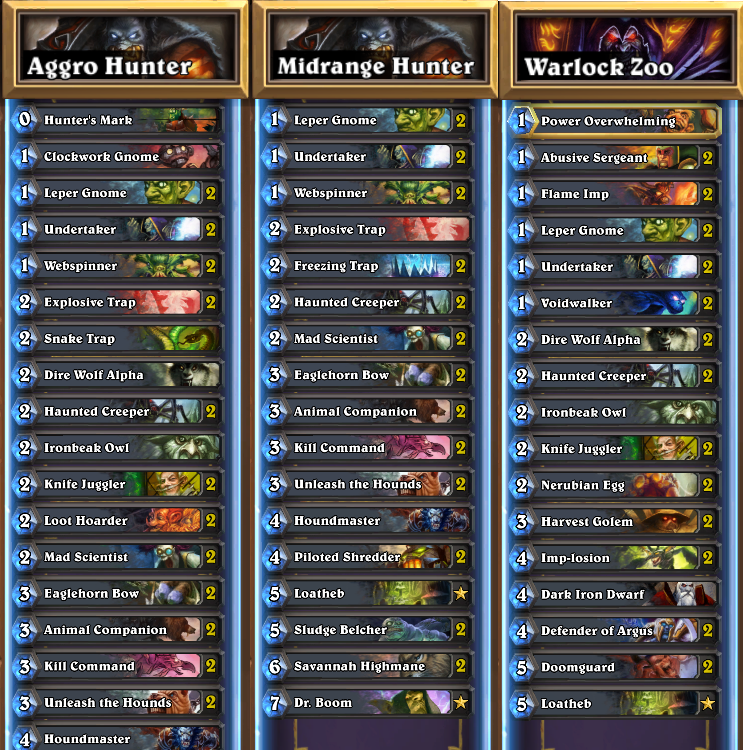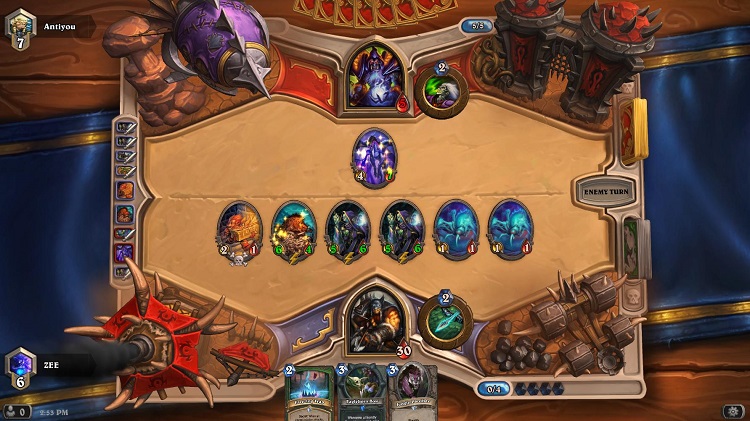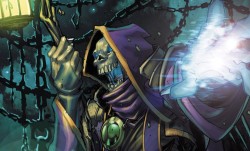Undertaker and why he was nerfed
Hey guys, it’s StoTheX. This is an article i originally published on GosuGamers, i hope you like it! I will be writing more articles in the future, on both sites!
Lately one of the hottest topics in Hearthstone has been Undertaker, a card that brought a number of problems to the game up to the point players were getting fed up with it.
So when Blizzard finally decided to address its lack of balance and nerf the card, the relief in the community was gigantic. Today, like in my previous article about ranked ladder, I want to take a critical look at the card and why the nerf was due for a long time.
In many players’ eyes, this 1-mana minion was the bane of their existence, as it could get scary very fast. With a deck build around Undertaker and its Deathrattle synergy, opponents were under constant pressure from as early as turn one, with the dreaded prospect of just getting snowballed out of the game.
If we take a look at the Hearthstone card pool, we’ll see that it contains a total of 33 deathrattle minion, eight class specific and 25 neutral ones. Although not all of those cards are fit for Undertaker decks, there are still plenty useful ones to make the card scary.
A very good indicator for the power of Undertaker was the rise of several decks trying to abuse its trigger: aggro and midrange Hunter, Warlock Zoo and Undertaker Priest. The former three in particular became meta defining decks with the coming of Curse of Naxxramas, showing just how much of an effect Undertaker had.
Since I haven’t seen too many Priests on ladder since GvG and the Undertaker version is a niche variation of the class anyways, I will focus on the other three decks for the rest of the article.
Let me give you some standardized pre-nerf decklists as a visual guide:

Now if we look at these lists we clearly see quite a lot of Deathrattle minions, making it pretty easy for Undertaker to show just how much a little guy could grow in the right environment. In fact, by taking a closer look at these lists we can see that about 1/4 to 1/3 of the decks are Deathrattle minions with mana cost three or less, strongly supporting an early Undertaker gameplan.
Adding these numbers to the probability of drawing an Undertaker for a turn 1 play (41,25 % for going first and 50,98 % for going second if you hard mulligan for it) it is clear that pre-nerf Undertaker was a threat you had to take serious, even though it’s just a one mana minion.
Now in addition to talking about the pre-nerf Undertaker itself, we should also take a better look at what cards could deal with it. Let’s start with minions that could challenge Undertaker stats-wise. For this, I took into account all classes and neutral cards.
At first glance, we find a lot of minions that could deal with a turn one 1/2 Undertaker: twelve 1-mana and 48 2-mana minions to be exact, including Power of the Wild and Explosive Sheep. These numbers are true as long as the pre-nerf Undertaker stayed a 1/2, but if we account for just a single Deathrattle minion to buff Undertaker, of those twelve 1-mana minions only three remain: Flame Imp, Zombie Chow and Dust Devil.
We can cross Dust Devil out of the list due to its nonexistence in professional games and move on to the remaining two. While Flame Imp traded with a 2/3 Undertaker 100 % of the time, Zombie Chow was kind of a gamble, because with 2 attack it can only trade over 2 turns, giving the opponent additional time to buff Undertaker, or trade into Zombie Chow with a different minion. In addition to this, both of these cards have drawbacks for the one playing them (losing 3 life or giving the opponent 5 life), so even if you could trade Undertaker you were still behind.
In the two mana category, 22 out of 48 minions are still able to either trade into the 2/3 Undertaker directly, just like Flame Imp, or have an immediate effect like Ironbeak Owl’s silence making it possible to trade. Looking at it from a different perspective, 54% of the time the 1-mana Undertaker got the better end of the deal clashing with a 2-mana minion after just one activation. And if we look at the mana curve and the amount of low cost Deathrattle minions in the Undertaker decks, we more or less had to assume that a turn 1 Undertaker would definitely get buffed at least once by turn 2, making it equal in stats with Zombie Chow but without any drawback.
Now let’s get to the spells and weapons section. I’ll only include cards that actually remove Undertaker from the board, so cards like Silence, or conditional cards like Execute, won’t be accounted for.
Currently there are eight 0-1 mana spells that could remove a 1/2 Undertaker directly, while only five of those could’ve still dealt with a 2/3 Undertaker. These five include Soulfire, which forces you to discard a random card, Naturalize, a card that lets your opponent draw 2 cards and Corruption, which removes a minion in the beginning of your next turn instead of doing it immediately, all which are disadvantageous for you to play.
Continuing on that path, we should also take a closer look at the 2-3 mana spells and weapons where 19 spells and seven weapons could’ve dealt with an unbuffed Undertaker, but only four out of seven weapons and 11 out of 19 spells with a buffed 2/3 version of the card.
I won’t take a look at more expensive cards, since spending 3 mana to remove a 1 mana minion is already a huge loss in value, which is also why I didn’t take into account any minion over the cost of 2 mana. Even if we stick to the low-cost cards, almost all of those result in some kind of disadvantageous situation for you, either thanks to some drawback or a big loss in tempo.
Looking at those numbers we see that handling an Undertaker was manageable, as long as it was only buffed once. The real problem began when it got to the stats of 3/4, which was possible as early as turn 2. At that point you were in for some pain and often enough the game was already decided right there on the spot.
I actually did a bit of math to find out the probability of getting a turn 2 3/4 Undertaker, using the probability for a turn 1 Undertaker play from above and Hypergeometric Distribution. Using these on the aggro Hunter list i provided earlier, i arrived at a 4,79 % chance without the coin and at a 10,84 % chance with the coin. The numbers for the other two lists are obviously lower, but still considerable high, which makes it clear in my opinion that Undertaker wasn’t a minion to mess with.
Now if you didn’t happen to have a silence effect in hand there was a high chance you weren’t able to remove Undertaker until turn 4 and later, giving it enough time to grow even further.
Right now there is just a single card in the game that can remove a turn 2 3/4 Undertaker, that doesn’t put you behind in some way: Shadow Word: Pain. Giving this situation even Corruption suddenly looks a lot better, which is somewhat ridiculous considering how bad the card actually is.
Since it was very hard to predict if Undertaker would grow out of your removal reach, the player facing it would often use the coin to remove it on turn 1. Other one mana cost minions in the game make you weigh your options to either remove it or not remove it immediately, while Undertaker pretty much forced you to do the former, most likely resulting in that tempo loss we mentioned.
To showcase the card’s power let’s compare Undertaker to similar cards and start with the most similar one: Secretkeeper.
Secretkeeper is a 1-mana 1/2 minion that gets +1/+1 when you play a secret. Sounds familiar? So why is Secretkeeper not played, or rather, why was the old Undertaker just so much better than it?
There are several reasons.
1. Secrets are either useless, too few in numbers or too expensive to use them efficiently with Secretkeeper.
2. Secrets are only available for 3 classes, while Undertaker and most Deathrattle minions are available for every class.
3. Deathrattle minions actually add to your board position immediately, while Secrets are spells with conditional triggers that don’t, most of the time.
4. Adding to reason 3: You can play around the secret’s trigger rather easily, while you can’t really play around someone putting deathrattle minions on the board.
 You would never get that playing Secretkeeper
You would never get that playing Secretkeeper
You could probably find even more arguments why Undertaker was that much better than Secretkeeper, but you get the idea. Let’s look at another similar and actually good minion: Mana Wyrm.
Mana Wyrm is a 1/3 Mage class minion, that gets +1 attack whenever you play a spell. Easily spotted is the fact that Mana Wyrm only gets additional attack value while the health always stays at 3, giving the pre-nerf Undertaker the edge in terms of survivability quite often.
If someone asked me before the official nerf how i would’ve changed Undertaker to bring it more in line with other one mana cost minions my solution would have been this:
1 Mana, 1/2: Has +2 attack when you have a Deathrattle minion.
So basically a Cogmaster for Deathrattle minions. Ever since I saw that card I felt like this is how Undertaker should’ve been from the beginning. Instead, Blizzard decided to go the Mana Wyrm route, except Undertaker didn’t get its health increased to 3.
While this lack of health buff may let you think it makes the current Undertaker worse than Mana Wyrm I’ll have to disagree.
First off, Mana Wyrm is a class minion which are supposed to be stronger than neutral ones anyways and secondly Undertaker still grows through putting Deathrattle minions on the board, which in general is simply the stronger ability condition. So in conclusion I would still give Undertaker a small edge over the Wyrm.
The last thing I want to talk about in this article before the final conclusion is a quote from a GameSpot interview with Ben Brode regarding Undertaker some time before the card was actually addressed. It goes like this:
“We did add some cards to Goblins vs Gnomes that are specifically good against Deathrattle decks. But The Undertaker is one of those cards that feels really powerful when he’s hurting you, but if you draw him late in the game he’s pretty terrible. We were paying attention to how people were using him, and looked at how we were playing against him, but we didn’t feel he’s nerf-worthy. He is very powerful, but it wasn’t past the line for us.”
The bolded part is what I want to talk here, because I think it’s an incredible weak argument and I can hardly believe it actually came from one of the guys making this game. In those bolded lines Ben sounds like he’s justifying Undertaker as being fine, because it’s only good in the early game and pretty terrible when you draw it late.
By game design, an early drop (and that is true for similar games as well) loses value over time, so the later you get to play an one drop for example, the worse it usually is. This is a wanted “game mechanic”, so justifying an one drop as ok, because it is lousy in the late game is kind of weird, especially coming from an actual game designer, not to mention that Undertaker was still infinitely better in the late game than most other early game minions thanks to the synergy.
The problem with that statement is simply the fact that it’s out of context. You just can’t measure the strength of an one drop accurately when you compare it to cards that are meant for later parts of the game. So instead we should compare Undertaker to other early game minions and if we do, we see that the pre-nerf Undertaker was easily the best one mana minion in the game and even topped most if not all two mana minions as well.
Looking back at my history with CCGs, I’ve played all kinds of decks, including extremely aggressive ones. In MTG in particular, one such deck was mono red burn, a deck that used a lot of direct damage spells and efficient low mana minions. Yet, these early game minions could never single-handedly dominate the game state just by themselves, something the per-nerf Undertaker did way too often because it lacked any drawback. Not only that, it also had the potential to snowball the opponent out of the game, which is too much value from a tiny one-mana minion.
With that being said, let’s all cherish the recent changes and enjoy a round of Hearthstone!

